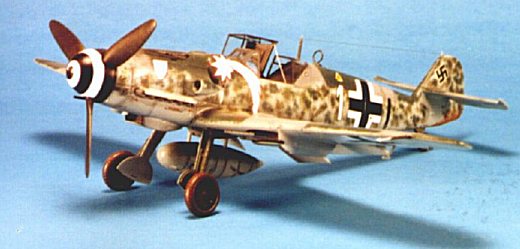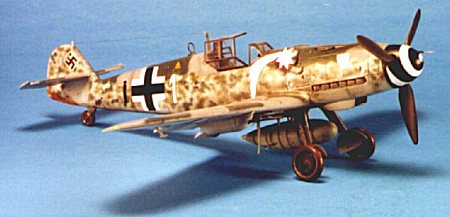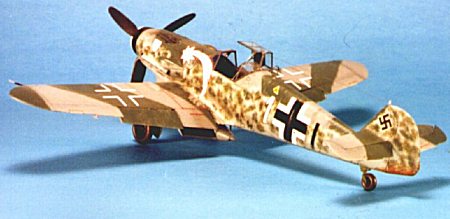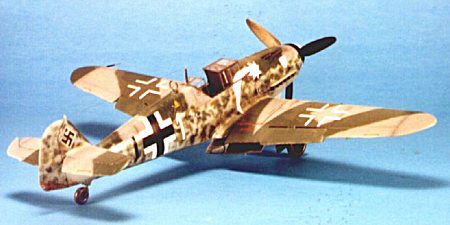
|
KIT: |
Hasegawa 1/48 Bf-109G-6 |
|
KIT # |
09324 |
|
PRICE: |
$22.98 |
|
DECALS: |
See review |
|
REVIEW & |
Tom Cleaver |
|
NOTES: |
"KANNONENBOOT" - Building a Bf-109G-6y/R6 from the Hasegawa Kit

|
HISTORY |
By 1943, it was clear to the Luftwaffe that the lightly-armed Bf-109G-2 and G-4 fighter (1 20mm cannon, 2 7.62 machine guns) was underarmed for the opponents flying against it on both the Eastern and Western fronts. In the West, the Jagdgeschwaders were equipped with two Fw-190 Gruppen for anti-bomber operations and one Bf-109G Gruppe to take on the escort fighters. More and more, though, both types were used against the bombers, and fighters like the P-47 were remarkably resistant to rifle-caliber machinegun fire.
The Bf-109G-6 marked the first upgrade in armament since the introduction of the Friedrich series. To accommodate the 13mm machineguns in the cowling, Messerschmitt's engineers came up with remarkably-unaerodynamic bulges that quickly led to the G-6 being called the "beule" (bumps) when it arrived on operations. Inasmuch as Adolf Galland had managed to have a Bf-109F modified with 13mm armament with very refined streamlined cowl bulges, one has to wonder why that design could not be carried forward.
 While this new armament
was more than satisfactory when used against the Soviet aircraft on the Eastern
front, it was apparent that even this upgrade was insufficient to assure a kill
against the B-17 or B-24 in the limited amount of time a pilot had to bring his
weapons to bear as he dove through the American formations. As early as the
Bf-109F-4, the Ruestsaetze Sechs (R6) had been available as a field
modification; this was a 20mm cannon in a gondola under each wing immediately
outboard of the main gear wells. The heavy weapons had a deleterious effect on
maneuverability in fighter vs. fighter combat, but in 1943 the Germans could
afford to wait until the escort fighters turned back for lack of fuel, before
commencing attacks on the bomber formations. Thus, the "Kannonenboot,"
or "gunboat" became the must numerous version of the G-6 to see combat
in the West. Of course, later in the year, and in 1944, the gunboats would be
"meat on the table" to P-47s and P-51s equipped with drop tanks that
enabled them to escort the bombers to the target and back, and by late Spring
1944, the guns were no longer to be seen, replaced by a 30mm cannon in the nose.
While this new armament
was more than satisfactory when used against the Soviet aircraft on the Eastern
front, it was apparent that even this upgrade was insufficient to assure a kill
against the B-17 or B-24 in the limited amount of time a pilot had to bring his
weapons to bear as he dove through the American formations. As early as the
Bf-109F-4, the Ruestsaetze Sechs (R6) had been available as a field
modification; this was a 20mm cannon in a gondola under each wing immediately
outboard of the main gear wells. The heavy weapons had a deleterious effect on
maneuverability in fighter vs. fighter combat, but in 1943 the Germans could
afford to wait until the escort fighters turned back for lack of fuel, before
commencing attacks on the bomber formations. Thus, the "Kannonenboot,"
or "gunboat" became the must numerous version of the G-6 to see combat
in the West. Of course, later in the year, and in 1944, the gunboats would be
"meat on the table" to P-47s and P-51s equipped with drop tanks that
enabled them to escort the bombers to the target and back, and by late Spring
1944, the guns were no longer to be seen, replaced by a 30mm cannon in the nose.
|
THE KIT |
As I have said elsewhere, Hasegawa has a lock on the Messerschmitt Bf-109 series, at least from the E-3 onward. I had expected to see the G-6 - the subvariant built in greater numbers than any other - several years before it finally showed up in 1999, but it was worth the wait. As with the other late-war versions, the G-10, G-14 and K-4, the fuselage engineering was changed to provide greater strength in the nose assembly than had been the case with the Bf-109F and early Bf-109G kits, with their separate cowling doors. The current kit differs with a new fuselage sprue, and a separate sprue of G-6 items, including both types of "beule", the heavier head armor, different instrument panel, upper wing wheel bulges, and larger tailwheel. All of this comes together easily when the instructions are followed.
|
CONSTRUCTION |
The new Osprey "Aircraft of the Aces: Bf-109F/G/K Aces of the Western Front" has some very interesting profiles of aces' aircraft. I had the Aeromaster sheet that included the striking "shooting star" insignia worn by 7.III/JG-3 during the period of the great daylight air battles between the Luftwaffe and the growing Eighth Air Force in the summer and fall of 1943, and decided to modify the decals by using only a "white 1" rather than "white 11" which was provided on the sheet, to create the airplane flown by Staffelkapitaen Hauptman Karl-Heinz Langer, a 30-victory experte who would survive the war as Kommandeur of III/JG3.
 Beyond modifying the
decal sheet, it was necessary to modify the Morane antenna for the FuG16ZY IFF
gear and attach it to the lower fuselage below the cockpit. In 1943, only
formation leaders carried this equipment, which allowed ground controllers to
better direct the formation onto the enemy.
Beyond modifying the
decal sheet, it was necessary to modify the Morane antenna for the FuG16ZY IFF
gear and attach it to the lower fuselage below the cockpit. In 1943, only
formation leaders carried this equipment, which allowed ground controllers to
better direct the formation onto the enemy.
This Bf-109G-6 carries the "classic" camouflage of RLM74 graugrun and RLM75 grauviolett over RLM76 graubleu, with a dapple of RLM02/71/74 on the fuselage sides. I used my mixture of Gunze Sanyo "IJN Green" and ""Blueish Grey" to creat RLM74, and Gunze Sanyo "Neutral Grey" as RLM75. For the other colors, I used the new Gunze-Sanyo "RLM76 Grey," and Tamiya's "RLM Grey" and "Dark Green". With the new airbrush tip and new air hose, it was easy to freehand the camouflage. After "pre-shading" flat black along all panel lines, I paint the entire fuselage, and lower wing and tail surfaces with RLM76. I then "dapple" the sides, and conclude with the upper surface greys in the standard "Bf-109G pattern." After a coat of Future, the model was ready for the decals.
My only departure from the information shown in the Osprey profile was to use the "corkscrew" decal on the spinner. While the book calls for the 1/3 white-2/3 black "strobe" spinner marking, the decal sheet calls for the "corkscrew," which was just coming into use in late 1943. Since it looks better, I chose it.
Once the decals were set, I Futured again, then used Tamiya "Smoke" to create the exhaust and gunfire stains. I then shot the model with "Flat Future," my mixture of Future and Tamiya "Flat Base," using three thin coats to end with a "satin" matt finish, as seen on German aircraft of the period.
I then attached the canopy in the open position, using a piece of stainless steel wire for the cable that kept the canopy from flopping all the way over when opened.
|
CONCLUSIONS |
 This kit is as good as
all the other Hasegawa Bf-109s, and is easier to assemble with the different
assembly engineering of the fuselage. With the veritable plethora of aftermarket
decals available for the "Beule," a modeler can have a ball doing
different markings for this most-numerous Gustav.
This kit is as good as
all the other Hasegawa Bf-109s, and is easier to assemble with the different
assembly engineering of the fuselage. With the veritable plethora of aftermarket
decals available for the "Beule," a modeler can have a ball doing
different markings for this most-numerous Gustav.
Thanks to Marco Polo Importers for the review kit